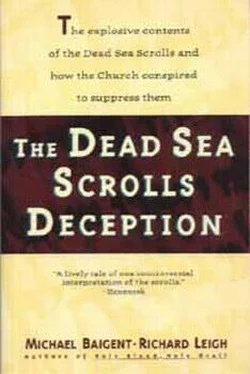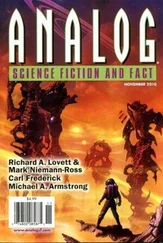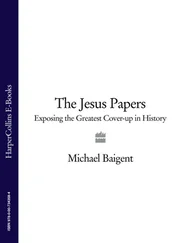’Zeal for the Law’ effectively brings the ‘Zealots’ — usually envisaged as more or less secular ‘freedom fighters’ — into alignment with the fervently religious members of the Qumran community; and, as we have already noted, Qumranic texts were found in the ruins of Masada. ‘Zeal for the Law’ also brings the ‘Zealots’ into alignment with the so-called ‘early Church’, to whose adherents the same ‘zeal’ is repeatedly ascribed. The figure cited in the Gospels as ‘Simon Zelotes’, or ‘Simon the Zealot’, attests to at least one ‘Zealot’ in Jesus’ immediate entourage; and Judas Iscariot, whose name may well derive from the Sicarii, might be another. Most revealing of all, however, is Eisenman’s discovery — the original Greek term used to denote members of the ‘early Church’. They are called, quite explicitly, ‘ zelotai of the Law’ — that is, ‘Zealots’. 21
There thus emerges, in 1st-century Palestine, a kind of fundamentalist dynastic priesthood claiming either genealogical or symbolic descent from Aaron and associated with the expected imminent advent of a Davidic or royal Messiah. 22This priesthood maintains itself in a state of perpetual self-declared war with the Herodian dynasty, the puppet priests of that dynasty and the occupying Romans. Depending on their activities at a given moment, and the perspective from which they are viewed, the priesthood and its supporters are variously called ‘Zealots’, ‘Essenes’, ‘Zadokites’, ‘Nazoreans’ and a number of other things — including, by their enemies, ‘brigands’ and ‘outlaws’. They are certainly not passive recluses and mystics. On the contrary, their vision, as Eisenman says, is ‘violently apocalyptic’, and provides a theological corollary to the violent action with which the ‘Zealots’ are usually associated. 23This violence, both political and theological, can be discerned in the career of John the Baptist — executed, according to the Gospels of Matthew and Mark, for condemning the marriage of Herod Antipas to his niece because it ‘is against the Law for you to have her’. And, indeed, Eisenman has even suggested that John the Baptist may have been the mysterious ‘Sadduc’ who accompanied Judas of Galilee, leader of the ‘Zealots’ at the time of Jesus’ birth. 24
To recapitulate, then, there emerge, from the confusing welter of sobriquets and nomenclature, the configurations of a broad movement in which ‘Essenes’, ‘Zadokites’, ‘Nazoreans’, ‘Zealots’ and other such supposed factions effectively fuse. The names prove to be merely different designations — or, at most, different manifestations — of the same religious and political impetus, diffused throughout the Holy Land and beyond, from the 2nd century BC on. The ostensibly separate factions would have been, at most, like the variety of individuals, groups and interests which coalesced to form the single movement known as the ‘French Resistance’ during the Second World War. At most. For Robert Eisenman personally, any distinction between them is but a matter of degree; they are all variations on the same theme. But even if some subtle gradations between them did exist, they would still have been unified by their joint involvement in a single ambitious enterprise — the ridding of their land of Roman occupation, and the reinstatement of the old legitimate Judaic monarchy, together with its rightful priesthood.
That enterprise, of course, did not end with the destruction of Jerusalem and Qumran between ad 68 and 70, nor with the fall of Masada in ad 74. In the immediate aftermath of the debacle, large numbers of ‘Zealots’ and Sicarii fled abroad, to places where there were sizeable Judaic populations — to Persia, for example, and to Egypt, especially Alexandria. In Alexandria, they attempted to mobilise the local Jewish population for yet another uprising against Rome. They met with little success, some six hundred of them being rounded up and handed over to the authorities. Men, women and children were tortured in an attempt to make them acknowledge the emperor as a god. According to Josephus, ‘not a man gave in or came near to saying it’. And he adds:
But nothing amazed the spectators as much as the behaviour of young children; for not one of them could be constrained to call Caesar Lord. So far did the strength of a brave spirit prevail over the weakness of their little bodies. 25
Here again is that strain of fanatical dedication — a dedication that cannot be political in nature, that can only be religious.
More than sixty years after the war that left Jerusalem and the Temple in ruins, the Holy Land erupted again in a new revolt, led by the charismatic Messianic figure known as Simeon bar Kochba, the ‘Son of the Star’. According to Eisenman, the terminology suggests that Simeon was in reality descended by blood from the ‘Zealot’ leaders of the previous century. 26In any case, the image of the ‘Star’ had certainly figured prominently among them during the period culminating with the first revolt. 27And, as we have noted, the same image figures repeatedly in the Dead Sea Scrolls. It derives ultimately from a prophecy in the Book of Numbers (24:17): ‘a star from Jacob takes the leadership, a sceptre arises from Israel’. The ‘War Rule’ invokes this prophecy, and declares that the ‘Star’, or the ‘Messiah’, will, together with the ‘Poor’ or the ‘Righteous’, repel invading armies. Eisenman has found this ‘Star’ prophecy in two other crucial places in the Qumran literature. 28One, the ‘Damascus Document’, is particularly graphic: ‘The star is the Interpreter of the Law who shall come to Damascus; as it is written… the sceptre is the Prince…’ 29
Josephus, as well as Roman historians such as Suetonius and Tacitus, reports how a prophecy was current in the Holy Land during the early 1st century ad, to the effect that ‘from Judaea would go forth men destined to rule the world’. 30According to Josephus, the promulgation of this prophecy was a major factor in the revolt of ad 66. And, needless to say, the ‘Star’ prophecy finds its way into Christian tradition as the ‘Star of Bethlehem’, which heralds Jesus’ birth. 31As ‘Son of the Star’, then, Simeon bar Kochba enjoyed an illustrious symbolic pedigree.
Unlike the revolt of ad 66, Simeon’s insurrection, commencing in AD 132, was no ill-organised conflagration resulting, so to speak, from spontaneous combustion. On the contrary, much prolonged and careful planning went into the enterprise. Jewish smiths and craftsmen pressed into Roman service would, for example, deliberately forge slightly sub-standard weapons. When these were rejected by the Romans, they would be collected and stored for use by the rebels. From the war of the previous century, Simeon had also learned that there was no point in capturing and holding fortresses such as Masada. To defeat the Romans, a campaign based on mobility, on hit-and-run tactics, would be necessary. This led to the construction of vast underground networks of rooms, corridors and tunnels. In the period prior to the revolt, Simeon used these networks for training. Subsequently, once hostilities had begun, they served as bases and staging areas, enabling the rebels to launch a sudden lightning assault, then disappear — the kind of ambush with which American soldiers, to their cost, became familiar during the war in Vietnam. 32But Simeon did not confine himself solely to guerrilla operations. His army included many volunteers from abroad, many mercenaries and professional soldiers with considerable military experience. Indeed, surviving records discovered by archaeologists have revealed that a number of Simeon’s officers and staff spoke only Greek. 33With such well-trained forces at his disposal, he could, on occasion, meet the Romans in pitched battle.
Читать дальше












